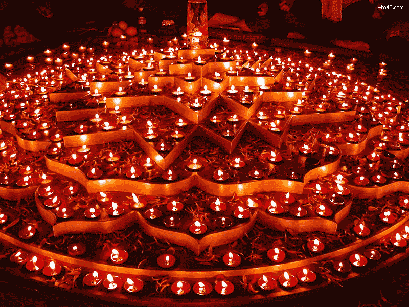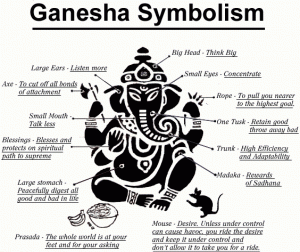 Ganesha the Hindu God is worshiped to mark the beginning of all auspicious occasions. We pray worship him for removing barriers of all sorts. The first prayer for a new beginning is always meant for Lord Ganesha. Ganesha, also called Ganapati, is the god of wisdom, discretion, and salvation. Ga means “knowledge”, na means “salvation”, and isha and pati mean “lord”. His illustration is universal. Ganesha is notably distinguished from other Hindu deities because he has the head of an elephant.
Ganesha the Hindu God is worshiped to mark the beginning of all auspicious occasions. We pray worship him for removing barriers of all sorts. The first prayer for a new beginning is always meant for Lord Ganesha. Ganesha, also called Ganapati, is the god of wisdom, discretion, and salvation. Ga means “knowledge”, na means “salvation”, and isha and pati mean “lord”. His illustration is universal. Ganesha is notably distinguished from other Hindu deities because he has the head of an elephant.
He is portrayed standing, dancing, heroically taking action against demons, playing with his family as a boy, sitting down or on an elevated seat, or engaging in a range of contemporary situations.
Ganesha is considered to be the Lord of letters and learning. In Sanskrit, the word ‘Buddhi’ and ‘Vidhya’ are feminine noun that is variously translated as intelligence, wisdom, or intellect. The concept of buddhi and vidhya is closely associated with the personality of Ganesha, especially in the Puranic period, when many stories stress his cleverness and love of intelligence.
 Lord Ganeshahe is known by many attributes. His Big Head specifies an agile brain within the big head. We’ve been conditioned to think small, simplify, not to be greedy, and to overall expect less and demand less from life. But, Ganesha’s Big Head is about big thoughts and big achievements. In our profession, if we cannot think big, we will never achieve big success. So the big head of Lord Ganesha depicts – think big and achieve big.
Lord Ganeshahe is known by many attributes. His Big Head specifies an agile brain within the big head. We’ve been conditioned to think small, simplify, not to be greedy, and to overall expect less and demand less from life. But, Ganesha’s Big Head is about big thoughts and big achievements. In our profession, if we cannot think big, we will never achieve big success. So the big head of Lord Ganesha depicts – think big and achieve big.
His small eyes symbolize importance of focus. By focusing, we gain deep expertise in our activity and expertise will help us becoming more effective. Any kind of distraction from the target can result in failure. Transitions are often wasteful. Every time you switch between movements or types of projects, you lose time and energy.
The big ears and small mouth indicate importance of listening skills. It symbolizes that while you hear to all, grasp well, make note of every detail. Good listening skills will help you to become a more productive worker. The small mouth tells us to speak less. We should give our ears to all, obtain what is needed and throw away the futile. Big ears and small eyes suggest ‘let your ears be ground’ but speak only when required.
note of every detail. Good listening skills will help you to become a more productive worker. The small mouth tells us to speak less. We should give our ears to all, obtain what is needed and throw away the futile. Big ears and small eyes suggest ‘let your ears be ground’ but speak only when required.
The Lord’s Long Trunk depicts that one should be able to smell future. What will the future smell like? This may sound silly. But, if we think, and are able to glean some insights into the future, smelling future is possible. Just like the trunk of the Lord can be moved into any direction, we should be able to get indications from all directions to detect opportunities, possibilities as well as threats. We must be able to detect dangers. The sense of smell is one of our most powerful connections to the physical world.
 The Big stomach indicates digesting all good and bad events in life. Our life is a pile of good things and bad things. Though good things don’t always alleviate the bad things, but vice versa, the bad things don’t always spoil the good things and make them unimportant. The big stomach of Ganesha teaches us to absorb all that is good, bad or ugly. Hostility, disappointments, hardships and resentment – we have to digest them to move on to better pasture of life.
The Big stomach indicates digesting all good and bad events in life. Our life is a pile of good things and bad things. Though good things don’t always alleviate the bad things, but vice versa, the bad things don’t always spoil the good things and make them unimportant. The big stomach of Ganesha teaches us to absorb all that is good, bad or ugly. Hostility, disappointments, hardships and resentment – we have to digest them to move on to better pasture of life.
Lord’s each of Four Hands suggest importance of giving and taking in life. One cannot expect only taking from others but giving is equally important. While there is grace in giving there is grace in receiving too. The left hand with modak means to receive good one should be ready to receive at the same time wish well of others. The right hand is raised to bless. Blessing is a very important part of our faith. The right hand at the back holds an axe; it symbolizes retrenchment. One should know when to cut, economize, reduce and retreat. The noose in the left hand at the back denotes importance of capturing good things. It indicates that one has to capture things that are helpful to our advantage. It also indicates that ‘opportunities knock at your door once, if you grab them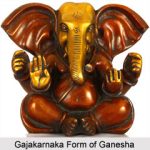 they are yours.’
they are yours.’
His Small Feet support his large body, leaves him with no choice but to be firmly grounded to avoid tumbling or falling. In our fast paced lives we need to be mentally and emotionally stable; worthily sensible, realistic and unpretentious. We get bogged down with multi tasking, stressful relationships, finances, jobs, social image, our prestige etc, etc. Ganesha’s small feet depict staying emotionally and mentally stable in life.
The Two Tusks of the Lord teach us that that little bit of sacrifices are worth it in life. The broken tusk has a story which goes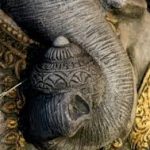 like this: when Sage Ved Vyasa came up with the idea of writing Mahabharatha, he looked around for someone who would write down the words even as he recited them. He approached Lord Ganesha and asked him if he would do so. Lord Ganesha readily agreed. Ved Vyasa said “I will narrate the story and you must take it down as fast as I say it and should not interrupt or stop anywhere in between” and Lord Ganesha too said that “I will do so and if you halt or hesitate, I will stop writing and your epic will never be written”. Ved Vyasa agreed with Ganesha’s condition. The elephant headed God broke one of his tusks to write Mahabharata and used it as a pen. To do good work, at times we need little sacrifices. The other message is that one must conquer emotions with wisdom to attain perfection.
like this: when Sage Ved Vyasa came up with the idea of writing Mahabharatha, he looked around for someone who would write down the words even as he recited them. He approached Lord Ganesha and asked him if he would do so. Lord Ganesha readily agreed. Ved Vyasa said “I will narrate the story and you must take it down as fast as I say it and should not interrupt or stop anywhere in between” and Lord Ganesha too said that “I will do so and if you halt or hesitate, I will stop writing and your epic will never be written”. Ved Vyasa agreed with Ganesha’s condition. The elephant headed God broke one of his tusks to write Mahabharata and used it as a pen. To do good work, at times we need little sacrifices. The other message is that one must conquer emotions with wisdom to attain perfection.
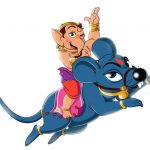 Mouse as his vehicle – Lord Ganesha with a huge body has a small mouse for his vehicle. It shows that Lord Ganesha has no ego. Ganesha’s modesty does not permit him to consider the mouse as insignificant; but he has reviewed the advantages that the mouse can offer him. The mouse can squeeze in t
Mouse as his vehicle – Lord Ganesha with a huge body has a small mouse for his vehicle. It shows that Lord Ganesha has no ego. Ganesha’s modesty does not permit him to consider the mouse as insignificant; but he has reviewed the advantages that the mouse can offer him. The mouse can squeeze in t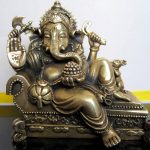 hrough the smallest space and can even help him commute during the night. Small is big. Ganesha teaches us to respect small objects, small people in our lives. He teaches us to leave aside burden of our big egos and to ride on a right path in life. We need to become small, shed our ego weight, be attentive to understand the advantages, which others have overlooked.
hrough the smallest space and can even help him commute during the night. Small is big. Ganesha teaches us to respect small objects, small people in our lives. He teaches us to leave aside burden of our big egos and to ride on a right path in life. We need to become small, shed our ego weight, be attentive to understand the advantages, which others have overlooked.
The Prasada at the feet of Lord Ganesh signifies that the whole world is at your feet – provided you look at carefully, and provided you want to pick the best from it. Nothing is impossible in life. Enjoy each moment of it. Life is full of surprises, and is very full of flavor. Enjoy life all the way.










































